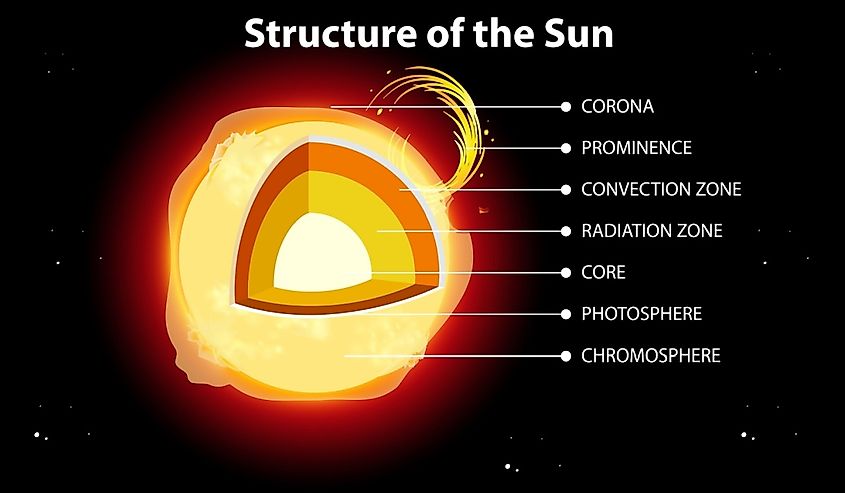
How Hot Is The Sun?
The great ball of fire in the sky (or rather, plasma, to be exact) holds the solar system together and provides the heat, energy, and illumination necessary to sustain life on Earth. And yet, the Sun itself is the most overwhelmingly inhospitable environment imaginable. Its core burns hot enough to sustain nuclear fusion, and its "surface," though relatively cool, is still capable of boiling diamonds. All the season-regulating, photosynthesizing, and mentally uplifting benefits we reap from our local yellow dwarf star is because of the Earth's goldilocks orbit. Any closer, and we would be scorched like Venus; any further, and we'd freeze like Mars. So just how hot is the sun? And how on earth do we measure that?
The Core

Just as with our blue planet, the hottest part of the Sun is its core. Here, nuclear reactions fuse hydrogen into helium, producing temperatures as high as 27 million degrees °F (15 million °C) in the process. If that were not impressive enough, the Sun's core measures a whopping 86,000 miles thick and has a density of 150 grams per cubic centimeter (i.e., eight times that of gold and 13 times greater than lead).
The intense energy created by the Sun's core shoots out in the form of radiation. For roughly 170,000 years (but as many as a million), it bounces around the radiative zone before reaching the convection zone (both of which, along with the core, constitute the Sun's inner regions), where temperatures drop to approximately 3.5 million °F (2 million °C) and begin to take the form of plasma bubbles. These pockets of ionized atoms shift up to the Sun's surface (i.e., the photosphere).
The Surface

Given its scintillating temperatures, the Sun does not have a solid surface. Rather, it has a (relatively) thin photosphere, which is the part of our star that projects the greatest amount of visible light. Even though the photosphere is commonly called the surface, it is actually the first layer of the Sun's atmosphere. This 250-mile-thick section registers at about 10,000 °F (5,500 °C), a fraction of the core's inferno, but still incredibly hot. For reference, magma reaches anywhere from 1,300 to 2,400 °F (700 to 1,300 °C).
The Atmosphere

Above the photosphere, the layers of the Sun's atmosphere continue with the chromosphere, the transition zone, and the corona. This outer region is where heliophysicists are able to observe solar flares, sunspots (some of which can reach 31,000 miles across), solar prominences, coronal holes, and coronal mass injections (whose projected particles can reach Earth). One thing that continues to puzzle the best and brightest sun scientists is the fact that the corona (i.e., the upper atmosphere) is substantially hotter than the layers beneath it. Despite the fact that this region is further from the core, and deeper into the frigid vacuum of space, the mercury rating (so to speak) once again jumps up to about 3.5 million °F (2 million °C). So, there is still more to learn about our solar system's focal point.
How Do Scientists Study the Sun?

NASA, ESA, and other international space agencies have deployed several spacecraft to help us better understand the inner workings of the Sun. These include: STEREO, the Parker Solar Prove, SOHO, IRIS, Wind, Hinode, the Solar Dynamics Observatory, and as of February, 2020, the Solar Orbiter. According to the European Space Agency, Solar Orbiter is "...the most complex scientific laboratory ever to have been sent to the Sun." This revolutionary spacecraft has been designed to get closer to the Sun than any of its predecessors (it will have to beat the Parker Solar Probe's record of 3.8 million miles), and is therefore able to send better quality images back to Earth, including pictures of the still-uncharted polar regions. Another hope is that Solar Obiter's sensors will also be able to shed light on why the corona is millions of degrees hotter than the photosphere. Progress has already been well underway. The very first images were released in July of 2020, and scientific operations commenced the following November.
Aside from orbiting spacecraft, heliophysicists rely on terrestrial telescopes and satellite-mounted cameras to make assessments on our star. A combination of spectroscopic data and the Sun's theorized physical processes allows scientists to make educated guesses about just how hot the Sun is across its various parts.
Stellar Facts About The Sun
The Sun is classified as a G2V star, meaning it is the second-hottest type of yellow G-class star, and that it is a dwarf main-sequence star (i.e., one that converts hydrogen into helium). This giant ball of gas and plasma has an equatorial circumference of 2,720,984 miles, and a radius of 432,287 miles, making it 10 times wider than Jupiter, and 100 times wider than the Earth. The Sun weighs approximately 4.4 × 1030 pounds, which is equivalent to roughly 330,000 Earths. In terms of volume, it would require 1.3 million Earths to fill its brilliant sphere. Everything in the solar system, all the planets, moons, asteroids, icy bodies, and debris orbit around the Sun, which itself drags all of that material around the supermassive black hole at the center of the Milky Way galaxy, a journey that takes some 230 million years.
At 4.6 billion years old, the Sun is estimated to be about halfway through its lifespan. Rather than explode, our star is destined to turn into a red giant (once it exhausts its hydrogen supply), engulf Mercury, Venus, and perhaps even Earth, before shrinking down to a planetary nebula with a white dwarf star at its center. Thankfully, we will either be long gone by that point, or we will have achieved interstellar space travel. Perhaps the steps we take today will influence that far-off outcome. For now, we find ourselves in the perfect time and place to reap the benefits of the incredibly hot, but miraculously-contained Sun. So do a few extra sun-salutations during your next morning yoga session, and thank your lucky stars that the Earth still has a synergistic relationship with our piping-hot overlord.











